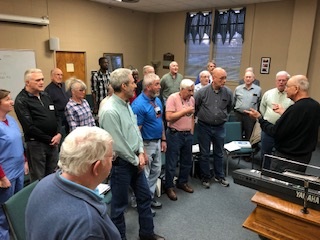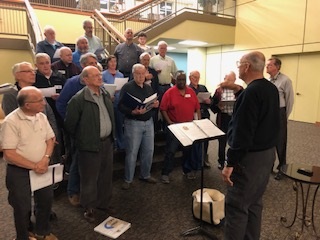
We rehearse every Tuesday evening from 6:00 to 8:30 PM at Mayfair Church of Christ, 1095 Carl T Jones Dr SE, Huntsville, AL 35802. Enter through Front Lobby or contact 256-653-4830. Guests are welcome at every rehearsal. As a first-time guest, we will ask you a few questions about your singing background and our director will help you select the proper barbershop part (tenor, lead, baritone, or bass) for your range. Then we will give you some music and start singing right away! We will ask an experienced member of your section to sing next to you so he can answer any questions you may have as the evening progresses. Don’t worry if you can’t read sheet music. We provide learning CDs for most of our songs and you can learn to read barbershop sheet music as your love for the hobby grows. All you need is the ability to match a pitch being played or sung. We can teach you the rest.
The Rocket City Chorus Sings Barbershop Style – What is that ???
Do you love music? If so, you’ve come to the right organization! Our chorus strives to take singing to the next level—not simply a single melody but rather four-part, a cappella harmony—music created from four different voice parts that beautifully blend into one chord. Stunning and challenging, all in one!
Close harmony is one of the trickiest yet most rewarding styles of any vocal ensemble. Imagine this: you’re singing a song with three other harmonizing voices, each hitting the perfect pitch when suddenly you hear it --- an overtone vibration, a resonant ring, an additional note than any one being sung by the 4 parts! This overtone produces a visceral experience and is unique only to four-part close harmony!
This is the foundation of Barbershop style — beautiful music, stunning chords, and a passion to create the intangible, moving essence of music that brings us together.
Here are the basics:
- You need to be able to sing in tune.
- You need to be able to hear those around you and blend your voice with theirs.
- You need to be able to eventually hold your own in a quartet of 4 voices — that is, you will need to be able to sing your own part when surrounded by those who don’t.
- You will probably want to begin a normal warm-up routine at home before you practice. This will be good for your voice, and depending on what you choose to do for warm-ups, you can specifically work on many different skills at once (e.g., flexibility, range, breath control, dynamic [volume] control, etc.).
- To keep your level consistent and/or improve, you will want to make sure you have a plan for practicing the songs at home, either with the help of learning tracks or not. It’s just like exercising the body—if you do it on a regular basis, you will reap the benefits, and if you don’t, you and others will definitely see the decline.
Voice Parts in Barbershop Singing
In simple terms, barbershop harmony is vocal harmony produced by four parts: lead, tenor, baritone, and bass. Finding the right part for your voice is the initial step. Any person of average singing ability, with or without vocal training, will find a part that fits their range.
There are certain things you may want to know depending on the part you will be singing. The LEAD voice generally sings the melody and is below the TENOR harmony; the TENOR part sings the highest note in the chord; the BARITONE part fills in the all-important missing note in a chord that may be above and below the melody; the BASS part supplies the harmonic foundation (root or fifth) of the chord. Like choral music, minimal vibrato should be apparent in barbershop singing. Wide and obvious vibratos tend to hamper the “lock and ring” that we look for in our chords.
TENOR is a harmony part sung consistently above the lead. The tenor should have a light, sweet, pure tone that will complement but not overpower or overshadow the lead voice. Light lyric sopranos generally make good tenors. The range for tenor is from G above middle C to high F on the top line of the clef. Occasionally you will have notes below the lead. When this happens, your tonal quality will need to change from being light and clear to being fuller and rounder. Flexibility is the key and knowing when you need to change.
LEAD is the melody and must be sung with authority, clarity, and consistent quality throughout the lead’s range. The lead sings with limited vibrato to add color and warmth to the sound. With too much use of vibrato, the chord will not “lock” or “ring” or produce the unique, full and “expanded” sound that is characteristic of barbershop harmony. The lead is responsible for conveying the interpretation, emotion, and inflections of the song. The range is equivalent to a Soprano II and is from A below middle C, and C above middle C. On the rarer occasions when the melody line is in another part, which may be only for a few notes, the lead will need to be aware to lighten their vocal quality to allow the melody to shine wherever it is being sung. If you are in a quartet, the others will follow your lead. In a chorus, we all follow the director.
BARITONE covers approximately the same range as lead. The voice part is like the equivalent of an Alto I except that baritone harmony notes cross the lead notes. Primarily sung below the lead but sometimes sung above, depending on where the melody is situated, baritones must constantly adjust their balance to accommodate their position in the chord. They must have a good ear.
BASS is the lowest note in the barbershop chord. Singers should have a rich, mellow voice and generally sing the root and fifth of each chord. The bass sings a relatively straight, well-produced tone with a minimum of vibrato. The range is comparable to that of a contralto or Alto II in traditional choral music. The range is from E-flat below middle C to G above middle C. Like the baritone, this part is written in the bass clef an octave lower than it is actually sung. A bass sings with a heavier tone quality than the others and generally with more volume, to provide the foundation of each chord.
If you all find this interesting, reach out to us or simply show up for one of our practice sessions.




